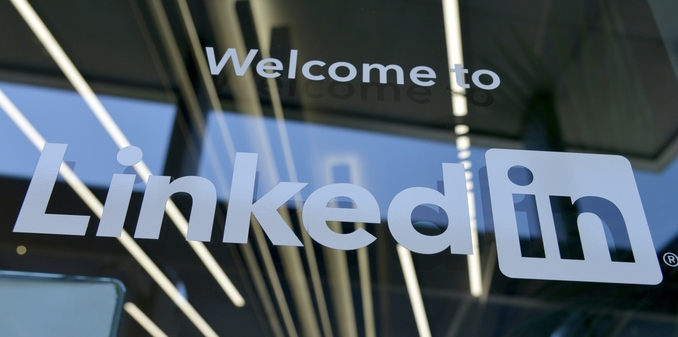Job Descriptions Guide
Dear job description enthusiast!
I've been studying job descriptions for 15+ years and below is a summary of the most important things I know. If you'd like to suggest changes, please email me and my team at (make sure to include both the information and the source of it).
I will update this page when I learn of anything new.
In the meantime, enjoy!
Rob Kelly, co-founder & CEO of Ongig
Table of Contents
- History of the Job Ad
- Why are Job Descriptions Important?
- Who Typically Writes Job Descriptions?
- Using Marketing and Copywriters to Write Job Descriptions
- EEO Statements in Job Descriptions
- Diversity in Job Descriptions
- Gender-Neutral Job Descriptions
- Readability in Job Descriptions
- Positive and Negative Word Use in Job Descriptions
- How Long Should Your Job Descriptions Be?
- Should Job Descriptions Include Salary?
- How to Write a Job Description (10 Tips)
- How Copywriters Write Job Descriptions
- Applying Psychology to Job Descriptions
- Writing a Title for Your Job Posting
- Sample Job Description Template (Internal)
- Sample Job Description Template (External)
- Insubordination Based Job Descriptions Duties
- Eliminating Job Descriptions?
What is a job description (versus job ad, job posting, etc.)?
A job description describes a role in a company. It is used both to advertise a job and to set expectations for employees once they have the job.
For this report, you'll find the following job description-related terms:
- Job descriptions -- An umbrella term for any page of content describing a role and the employer's expectations for that role.
- Job postings -- A public-facing ad appearing on a job board. A job post may be free (organic) or paid (e.g. a job ad).
- Job ads -- This is an advertisement for the job paid for by the employer.
- Job adverts -- Same as a job ad but some regions (such as the United Kingdom) use "advert" instead.
- Job reqs -- Stands for "job requisition" which is used internally to request a hire.
- Job pages -- A broad term describing a page with content about a job opening.
- Job profiles -- Another broad term used for a lengthier or shorter version of a job. description. For instance, a lengthy job profile might entail details about the team, names of customers and numeric goals.
- Misc -- There are numerous variations of the above such as position summary, position description, job spec, etc.
A Brief History of the Job Ad
I believe there have been 3 major eras in job ads and we're just on the cusp of the third!
They are:
- Help Wanted & Classified Ads
- The Job Boards & Applicant Tracking Systems
- Performance-based Interactive Job Ads
"Help Wanted" Job Ads
The first era of job ads was the "Help Wanted" era and it had 2 chapters:
- The Help Wanted Signs
- Classified Newspaper Ads
"Help Wanted" signs have been around nearly as long as businesses have.
It was the year 1439 when the first important job ad technology was invented: the mechanical movable type printing press. Johannes Gutenberg's printing press has a multiplier effect on the world because it made:
- Printing easy and affordable (e.g. a Help Wanted sign or a newspaper (more on newspapers below))
- More writing to be printed which motivated more people to read (spreading literacy)
By the 1600s, retail stores also began adding glass windows (which had just become affordable). Suddenly, Help Wanted signs in store windows became commonplace.
In 1605, the first newspaper (Germany's "The Relation") was published. By the 1800s advertisements began to be "classified" into groups (houses, jobs, etc.).
The classified job ad was born!
Many consider this "Men Wanted" ad below by explorer Ernest Schackleton to be one of the best job ads ever.
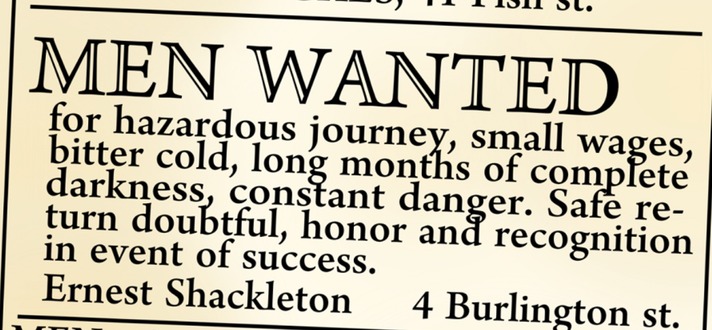
Image Source: Shackleton & Endurance 2016
Note: The Shackleton ad is said to have run December 29, 1913 but it's existence has never been proved.
During World War II (1939 to 1945), "help-wanted" advertising increased even more as men left their jobs to join the army.
Job Boards
In August 1992, Bill Warren founded the Online Career Center (OCC), the first employment site on the Internet (source: Wikipedia).
DICE launched a bulletin board service in San Francisco back in 1990 and then the full-blown Dice.com web site in 1996 (source: Wikipedia).It was quickly followed by Monster (which later bought OCC) and NetStart (later renamed CareerBuilder) in 1994.
These pioneering sites were soon called "job boards" and the ads on them were called "job ads" or "job postings".
Monster: One of the first job boars.
Job board distributors entered the fray around 1994 -- they allowed employers to get your job posting listed on numerous job boards at once. eQuest and CastleLinks were likely the first job board distributors, recalls Kelly Robinson of Broadbean Technology. Broadbean later acquired CastleLinks. ZipRecruiter later offered job board distribution as well.
Applicant Tracking Systems
A key turning point for job descriptions was the arrival of the applicant tracking system in the mid 1990s. The ATS would become the system of record for creating a job requisition ("job req').
A few early and major ATS milestones:
- In 1996, Canadian Martin Ouellett created Viasite, a French-language job board that was an early form of an ATS.
- In 1999, Ouellet and Louis Têtu renamed Viasite to Recruitsoft and set up headquarters in San Francisco.
- Brassring, another ATS, was founded (1999)
- Recruitsoft, Inc. changed its name to Taleo Corporation (March 2004)
- Kenexa has its initial public offering and buys Brassring (2005)
- Taleo acquires the ATS Vurv (aka Recruitmax) in July 2008.
- Oracle Corporation acquired Taleo Corporation for $1.9 billion (On February 9, 2012)
- IBM bought Kenexa for $1.3 billion (August 27, 2012)
Employers could now use an ATS to create a job description for internal and external hiring. See the Sample Job Description Template section below for differences between internal and external job descriptions.

Taleo: One of the first ATS systems
The ATS helped power employers' own company career sites (lowering their reliance on job boards).
HR Tech Influencers Mervyn Dinnen and Matt Alder pointed out (in their book Exceptional Talent) that in this new era:
"Information on available jobs all over the world was n
ow available 24 hours a day, seven days a week -- companies could use their career sites to sell themselves as employers on their own terms...."
Interactive Job Ads (Performance-based)
In 2004, a new era began for the Web called "Web 2.0" and the "Social Web". While Job boards and ATS's generated mostly static text-based job postings, the new Web 2.0 era ushered in :
- Interactivity (including video)
- Usability
- User-generated Content
- Social Media
Around this time, you began hearing new buzzword terms for the job description such as:
- Interactive job description
- Multimedia job description
- Enhanced job description
- Social job ad
- Visual job description
- Next-Gen job description
- Dynamic job description
- Video Job Ad
The applicant tracking system alone could not generate such content-rich pages. As HR Influencer James Ellis pointed out in The End of the ATS:
"Applicant tracking systems were never meant to be pretty (external), they were meant to help manage workflows (internal)”.
Around this time, new platforms emerged to put a pretty face on text-only job pages.
TMP's TalentBrew offered Advanced Job Descriptions (AJDs) that included the employer's logo, color scheme and new things such as maps and links to nearby restaurants.
On the job board side, job postings got a major facelift when LinkedIn launched its social network (December 2002).
Photo by Greg Bulla on Unsplash
With LinkedIn, a candidate could now see a job ad that showed mutual connections they had with an employer. A candidate could see a picture of the person posting the job along with their social media profile.
LinkedIn quickly became, as HR Tech expert Hung Lee put it, an "essential/ubiquitous" tool for recruiters.
Video Job Ads
Video played a key part in this. Video job ads began to appear as early as 2007 (check out ExpertVillage, an instructional Web site, with his video job ad for a news reporter).
Suddenly, these new Web 2.0-type job descriptions could have an impact on employer branding
HR Tech influencers like Tim Sackett began to recommend the importance of using video and pictures in job descriptions.
At first, many of these new dynamic job ads were one-off pages. But soon there were job description platforms.
In 2011, Ongig launched its job description marketing platform that let employers attach video and pictures to the job description text coming out of their ATS. Candidates could see a video or gallery of pictures of the job, view employer ratings and reviews and chat directly with the candidate.
"Smart companies are fostering this by thinking of job descriptions as content rather than advertisements".
-HR Tech Influencer Bill Boorman
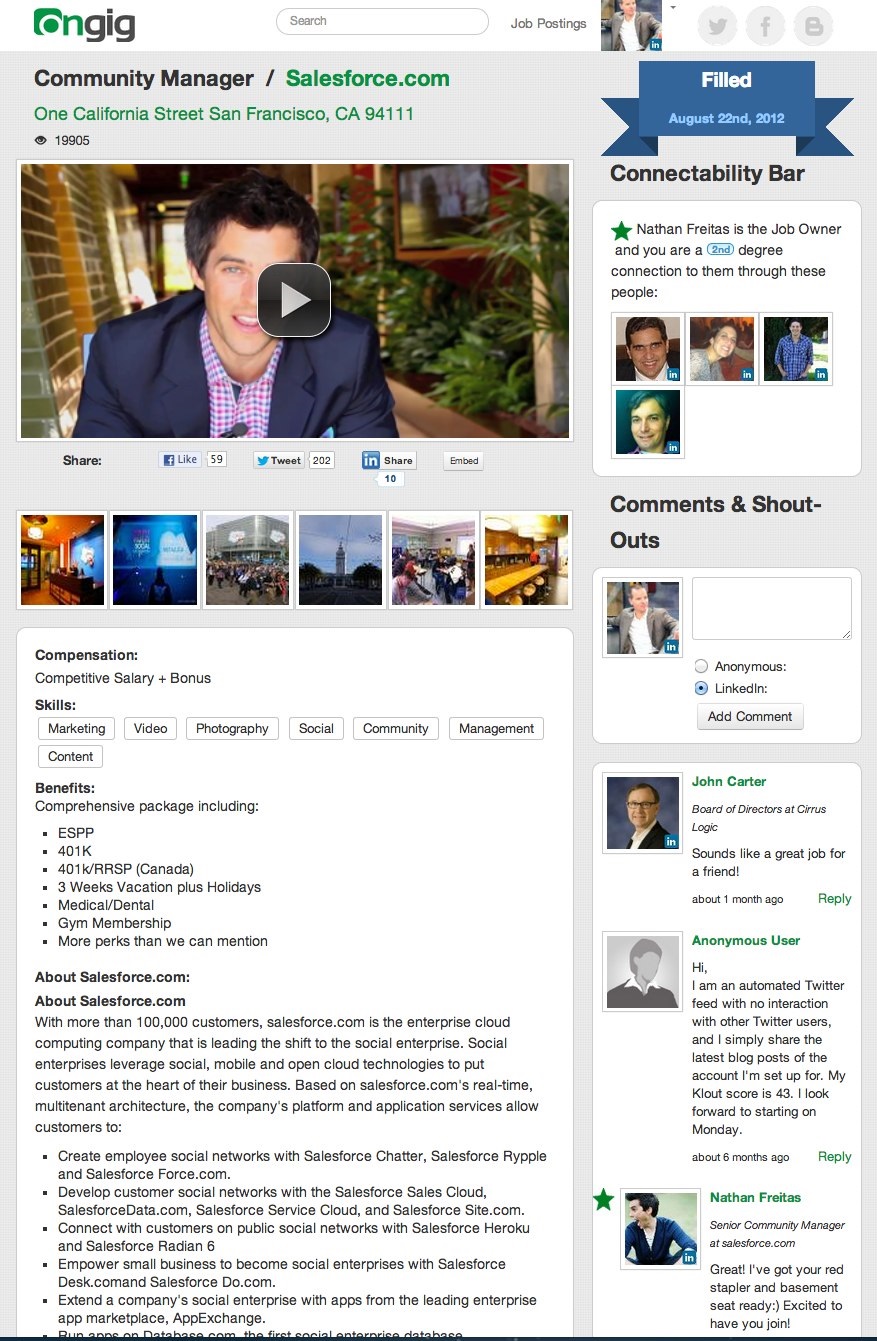
Performance-Based Job Ads
In 2014, job descriptions began to be measured in new important ways.
Textio was founded and used artificial intelligence/machine learning to measure what impact an individual word or phrase has on a job description's apply rate. Ongig could tell you how to boost your apply rate through a change in video or picture or engaging in a chat.
Appcast and other technology companies helped you target candidates with programmatic job advertising.
Google launched Google Cloud Job Discovery (later renamed Cloud Talent Solution) that impacted job descriptions because candidates could now:
- Search for jobs using natural language (abbreviations, concepts, etc.) not just plain keyword search
- Find recommended jobs tailored for them
The concept of machine learning on job descriptions is that the system gets smarter with every click. This can further increase key metrics like apply rate and quality of candidate.
In short, during this new "interactive, performanced-based" era, job descriptions have become more dynamic and data-driven.
Why are Job Descriptions Important?
Job descriptions are important for 3 main reasons -- they:
- Describe the hiring managers' needs for the role
- Include the main content advertising the job
- Give guidance to the employee hired for the job
Who Typically Writes Job Descriptions
A JD is written by one of 4 people depending on the size of your business:
- The Hiring Manager
- The Recruiter
- Someone else in HR
- Marketing or Copywriter
Often it's a combination of 2 or more of the above.
Check out The 8 Key Stakeholders in a Job Description Rewriting Project to see all the people involved in a job description rewriting project.

In a large company, the workflow of job descriptions is usually:
- The hiring manager makes a request for a new job (aka "job req') and gives a basic description of the job to HR.
- HR approves or rejects the job. If they approve it, they typically recommend a "Grade" of so that they can attach a salary to it.
- A recruiter or someone else in HR might brainstorm job descriptions with the hiring manager and even co-write it.
- A final JD gets approved by HR.
- The job is posted on the employer's applicant tracking system.
- The job then often appears publicly because job boards scrape an employer's career site or the employee buys an ad from the job board.
Using Marketing and Copywriters to Write Job Descriptions
Some employers will leverage their Marketing department to write job descriptions. Marketing team members will likely also get involved if you are including the following in your job descriptions:
- An About Us type section
- Media (video or pictures)
- Branding (color scheme, logos, font style and header/footer layout)
- Testimonials from employees
Another way to write a JD is to hire a copywriter from an outside consultant or recruitment agency. If you want to learn the difference between how an amateur and a pro writes a job description, check out the How Copywriters Write Job Descriptions section below.
EEO Statements in Job Descriptions
If your employer works with the government or is publicly-traded then Your Legal department will usually get involved in reviewing JDs. Their main concern will be that your EEO language is in compliance.
Check out:
- 10 Samples of an Effective EEO Statement
- Caution: Are You Using the “Kitchen Sink”-Style EEO Statement?
- How Unreadable is Your EEO Statement?
Diversity in Job Descriptions
Many JDs now include a Diversity Statement. This is sometimes combined with an EEO Statement or might be standalone.
HR Influencers Sabrina Baker and Christine Kopp point out that:
"One way to express your commitment to diversity and inclusion is by including your diversity statement on your postings. If it’s lengthy, you can make it small statement on your posting and link back to the full statement on your careers page."
-How to Use Inclusive Job Descriptions to Attract Top Talent for Your Small Business
If you have a Diversity team or Head of Diversity, she will likely craft your company's diversity statement.
Gender-Neutral Job Descriptions
The vast majority of JDs are biased towards men which means that you are likely losing quality female candidates due to your masculine biased job descriptions.
You're also going to want to make sure that your JDs are gender-neutral to attract both men and women. There are now job description text analysis tools such as Ongig, Textio, and Talvista (formerly Talent Sonar and Unitive before that) that will tell you if your JDs appeal more to men or women.
These gender-neutralizing text analysis tools work based on a combination of a database of words proven to attract men and women and artificial intelligence (tracking the clicks on apply of a JD by men and women related to the words used in those JDs).
Some studies show that women are different than men when it comes to the types of job posting they will apply to. For instance, an HP study showed that men apply for a job when they meet only 60% of the qualifications, but women apply only if they meet 100% of them.
So, one tip to attract more women is to:
- Limit the requirements of the job to must-haves
- Use softer language in your requirements like these from Hubspot:
- "familiarity with..."
- "bonus points for..."
- "working knowledge of..."
- "comfortable with..."
- "if you have any combination of these skills..."
And don't forget about how visuals affect diversity in your job ads. For instance, if you're trying to hire more women
"Don’t show two men in their 40s in your posting...Make your postings represent your diversity goals."
-Sabrina Baker and Christine Kopp
Readability in Job Descriptions
A good job description needs to be readable...just like a good book or text ad.
Check out Wikpedia’s Readability entry. Readability takes into account length of words and sentences, number of syllables, use of pronouns and much more.
Writing readable copy means writing in Plain English as HR Tech Analyst Matt Charney wrote:
"No one makes an emotional connection with company acronyms, industry keywords and bulleted lists. Formal language like “ideal candidate" or "top performer" can often hinder time to fill, time that could often be saved by simply addressing the person straight on, without all the fluff or purple prose."
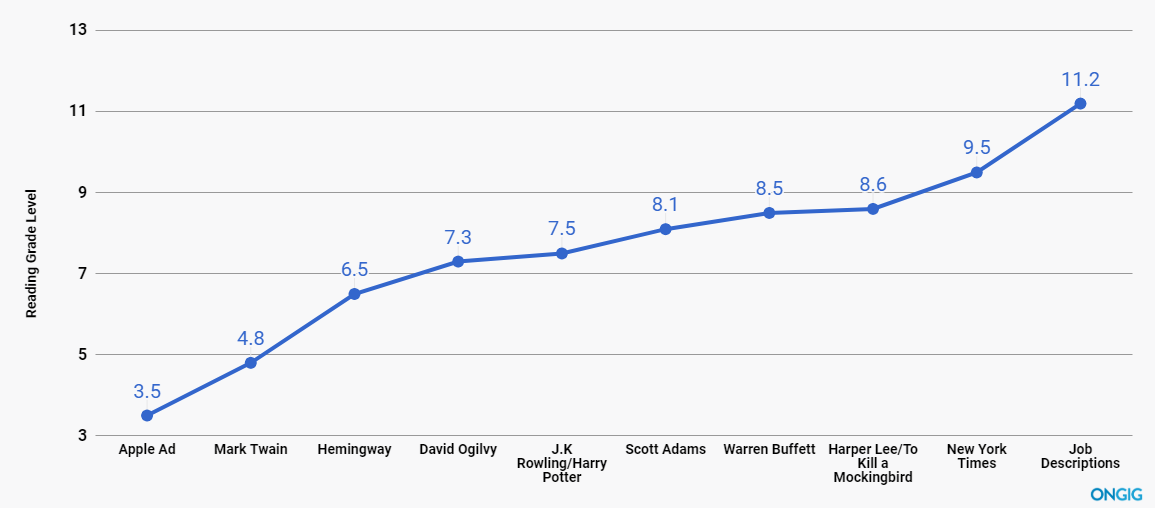
But most job descriptions are not written in Plain English.
Most job descriptions are written at a 11.2 average grade level according to my analysis of 3,500 job descriptions in June of 2018. However, they should be written at a much lower grade level (8th grade or lower) to attract busy candidates (see Why I Write My Job Postings at the 8th Grade Reading Level (or Lower!).
Some of the most readable text out there is at 8th grade or lower readability:
- Apple Ad (“Here’s to the Crazy Ones”) by TBWA Chiat/Day = 3.5 grade level
- Mark Twain’s The Adventures of Huckleberry Finn = 4.8
- J.K Rowling’s Harry Potter Series = 7.5
- Warren Buffett (first 6 pages of his annual report): 8.5
Note: The grade level is based on grades of the U.S. school system where 1st grade is an early year of schooling and 12th grade is senior year of high school.
Positive and Negative Word Use in Job Descriptions
Humans have positive and negative reactions to different words.
Dr. Andrew Newberg, a neuroscientist at Thomas Jefferson University, and Mark Robert Waldman, a communications expert, wrote the book “Words Can Change Your Brain."
In it, they write that “a single word has the power to influence the expression of genes that regulate physical and emotional stress."
And negative words have the power to negatively influence the reader.
Examples of positive words in job descriptions include:
- Love
- Growing
- Focused
- Transform
- Empower
- Meaningful
- Energy
- Relationships
Examples of negative words I've seen in job descriptions include:
- Abnormal
- Defective
- Stressful
- Unpopular
- Not
- Repetitive
- Stress
Some legal departments might insist you use certain negative words in a disclaimer section of your job description (e.g. work is "hazardous" to your health because it involves heavy lifting of 40+ pounds).
I recommend that at least 95% of the words you use in your job descriptions be positive (the 5% accounts for the words that Legal might mandate you use).
How Long Should Your Job Descriptions Be?
Opinions on the most effective length of job descriptions vary:
- Textio recommends job postings be 300 to 700 words in length and they say it's trending downward.
- TheMuse says that job descriptions containing less than 250 words got the same number of clicks as those with 1,000 words. There are some exceptions. Social media job descriptions got 2.8X more apply clicks if they were under 750 words versus over 750. And some JDs that require more technical explanations got nearly 2X the clicks if they were higher than 750 words.
- Appcast reports that job descriptions with 300 to 800 words receive the highest apply rate (8% to 9%), according to its 2018 Recruitment Media Benchmark Report.
I recommend 300 to 750 words per job description with exceptions. For example, an entry level call center job might need to include a description of the training program with the actual schedule (that requires extra text that most job descriptions don't need).
Should Job Descriptions Include Salary?
A strong argument is made to include compensation on job descriptions:
- Job listings with a salary range got 75% more clicks than job listings without, according to Stack's Engineering Manager Matt Sherman.
- Candidates spend more time looking at salary info than anything else, according to this heatmap of what candidates look at on a job description by Content Marketer Greg Lewis of LinkedIn.
- The #1 complaint from candidates is that a job doesn't have the pay (source: Marketing expert Lauren Holiday.)
That's one of many reasons Ongig began offering employers the option to include a Glassdoor Widget showing salary estimates on their job descriptions.
How to Write a Job Description (10 Tips)

Source: Ellyot on Unsplash
To write a good job description, you might keep these 10 tips in mind:
- Put first things first -- Well written job descriptions begin with something that captures the attention of the candidate and gets them to keep reading!
- Think like Google -- Be specific with your language. The world is vast. If you need a Full-Stack Engineer, use language that appeals to them (not language that appeals to all developers).
- Minimize fluff -- The candidate is busy. If it's a sales job and the candidate will use "Salesforce CRM" then say that instead of just "CRM".
- Keep sentences short and punchy. I recommend 8 words or less for your job descriptions. Check out these stats from The Public Relations Society of America:
- When the average sentence length is 8 word sentences, readers understood 100% of the story.
- At 14 words, the understanding rate drops to 90%.
- At 43 words per sentence it was below 10% understanding rate.
- Short paragraphs -- I make limit each paragraph of my job descriptions to 1 to 3 paragraphs.
- Active voice instead of passive voice. For instance, here’s active voice (good): “Google is innovating the field of A.I..” Here’s passive voice (bad): “The field of AI has been innovated by Google."
- First person/second person versus 3rd person -- Writing in f1st person (“We” and “Our)/2nd person (“you” and “your”) has the critical advantage over 3rd person (“It”, “[name of company], “[name of job]”, etc.) because it is more conversational.
- Bullets give readers a break -- I have found that that the most readable job descriptions have about 30% of the content bulleted
- Don't always spell out numbers -- "We are a top 3 brand in coffee" is preferable over "We are a top three brand in coffee" because it gives the eye a break.
- Forget what your English teacher taught you -- There are a bunch of rules you may have learned in English class. Disregard them. You are writing an ad here not being Shakespeare. E.g. you can begin your sentence with “And” or "But” as long as makes your JD more readable.
Check out 10 Tips for Writing Effective Job Descriptions for more details on how to write your own job posting.
How Copywriters Write Job Descriptions
![]()
Source: Photo by rawpixel on Unsplash
It pays to implement JD writing tips from the experts. A copywriter writes a job posting with the following 4 things in mind:
- Think benefit first -- "The first paragraph should tell candidates why they should come to work for you, before you ever get into the specific job details," according to Lori Sylvia of Rally Recruitment Marketing. Try including the tangible benefit of the job in the first one or two sentences. For instance, if it's a software developer job for a large company that has millions of customers than the opening line of your job description might read: "How would you enjoy writing software that will be used by millions!?"
- Team -- Most JDs should mention the team that the candidate is joining. People want to join groups of people (not just your entire organization).
- Day in the life -- Effective job descriptions help the candidate imagine a true day in the life in the role. You might consider an entire Day in the Life section for all your job postings that includes things like: Have a daily meeting with your team, Prepare and give a presentation to leadership, Meet with XYZ type of partner, or Blow off steam with your team in our monthly Happy Hour hangouts.
- Alienate the Non-Prospect -- Your JDs should always turn off the candidates you don't want applying. In marketing, we call this "alienating the non-prospect." If this job posting includes 20 hours a week of spreadsheet work then include that. Your best candidates will love that!
And good job ad writers always answer the "why" question the candidate has. Ben Gledhill of Yodell sums this up nicely:
"Job Descriptions need to start truly selling the role from not just a skills/experience purpose but from an emotional perspective with a real focus on the purpose and the why for the candidate."
Check out How to Write a Job Description Like an Ad Copywriter for 5 easy tips on how to turn your JD into a real ad!
Applying Psychology to Job Descriptions
In 2014, HR Tech Influencer Matt Buckland wrote in Why Job Adverts Suck and What You Can Do About It that job descriptions would be a lot more effective if they applied psychology such as Abraham Maslow's Hierarchy of Needs.
He emphasized that job description writers should tap into motivators such as Financial Gain, Job Security and Benefits, Team, Individual Opportunity and Personal Growth.
Buckland beat me on this topic by 4 years (sorry Matt, I only read your thoughtful article after I had written mine!). Here's my version of Maslow's Hierarchy of Candidate Needs (for Job Ads).
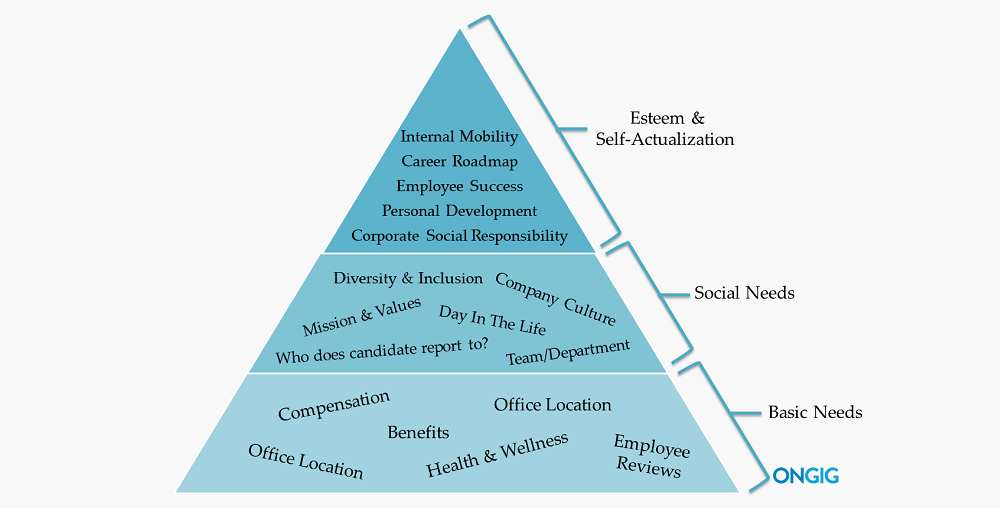
Writing a Title for Your Job Posting
I don't believe that great job descriptions have to have great titles. Sure, if you have a professional ad copywriter (think Don Draper of Mad Men) who could write a different title for each job, go for it. But my advice is to keep it simple.
Titles for job descriptions should be:
- Crystal Clear -- Be literal. If it's a software developer job, call it a "Software Developer". This will also help your rankings on Google as people are more likely to search "Sales Rep" than "Manager of Growth"
- Not cute or clever -- Steer clear of using clever words like "Ninja" or "Guru" or "Genius". They will only confuse candidates.
- Short -- Your job title should typically be less than 60 characters long for Google purposes. A good best practice is to start off writing it 10 to 20 characters long and go longer only for exceptions. For instance, "Sales Representative" is a fine title for most sales job but if you're Walt Disney Company and you're hiring a Sales Rep for your Cruise Line business then the title might need to be "Sales Rep, Cruise Lines".
Once you've nailed the job title, you need a consistent job description template.
The format for job descriptions are different based on whether it's for internal or external purposes (though some employers use the same JD for both).
Sample Job Description Template (Internal)
Here's a sample of a job description template that might be used internally:
Job Title: e.g. Sales Rep, Developer
Job Type: e.g. Part-time, full time, etc.
Job Location: e.g. 50 Broadway, New York, NY 101583 or New York, NY
Reports to: e.g. Reports to VP of Sales James Murdoch
Job Responsibilities
- Maintain a clean and safe workspace, and abide by workplace health and safety policies and procedures
- Other tasks as directed
Job Requirements (or "Skills & Experience")
- Computer Science degree
- 5 years experience developing front-end web applications
- Effective presentation skills
- Working knowledge of agile computing tools such as PivotalTracker
Compensation
- $75,000 per year
- Bonus of up to $10,000 for reaching performance goal below
Performance Goals
- Write 25 web application features by June 30th.
Sample Job Description Template (External)
An external job description is often called a job posting or job ad).
It might look the same as the internal JD but exclude the name of the direct report, the actual compensation and the performance goals. It might also add an "About Us" section and EEO/Diversity Statement.
Here's a sample job description template you might use externally:
- Job Title
- Job Location
- Job Summary/Intro
- Job Responsibilities
- Job Requirements (Must-Haves and Nice-to-Haves)
- Compensation & Benefits
- About Us (if the company is very large such as Disney it might also include an About Team)
- EEO Statement/diversity
I wrote this job description writing guide in which I included the general job description format used by some top companies. Some job description template examples include:
Apple
- Job Summary
- Key Qualifications
- Description (About Team, Responsibilities)
- Education
- Additional Requirements
Deloitte
- Summary
- Work you'll do
- The team
- Qualifications
- How you'll grow
- Benefits
- Deloitte's Culture
- Corporate Citizenship
- Recruiter Tips
- Summary (About Us, About You, About Tea,. Qualities)
- Responsibilities
- Requirements
Aflac
- The Division (About Team)
- Prinicpal Duties & Responsibilities
- Education & Expertise
- Job Knowledge & Skills
- Competencies (Core, Core Manager)
- Benefits
Pwc
- Summary
- Job Description (About Team)
- Position/Program Requirements
You can see that the job description format varies by number of sections. They also vary by the point of view from which they're written. For instance, some are 1st/2nd person ("We" and "You/Your") while others are third-person (About Team, Requirements, etc.).
Some employers have even eliminated job descriptions altogether.
Insubordination Based on Job Description Duties
A job description is sometimes used to prove insubordination.
Anniken Davenport, an employment law expert at Davenport Communications, described how this works in Insubordination in the workplace: Managing misconduct:
"Generally, three elements must be present to constitute insubordination:
- The employer (manager, supervisor, etc.) has given the employee an order.
- The employee acknowledges the order.
- The employee willfully refuses to carry out the order.
Anniken goes on to say that a manager's orders can be verbal or written. The duties listed in the employee’s job description are "essentially orders", Anniken says. If an employee refuses to perform those duties, that's insubordination.
Eliminating Job Descriptions?
In May 2014, Zappos eliminated job postings in favor of having candidates join their Zappos Insiders program. This was part of an innovative program led by Stacy Donovan Zapar that received encouraging results. Zappos (as of November 15, 2018) uses both the Zappos Insiders program and a listing of job descriptions on its site.
I enjoyed sharing this summary about job descriptions and look forward to updating it for you from time to time. Please write to if you have anything important about job descriptions that you think I should add.
Thx,

Rob Kelly, Co-founder & CEO of Ongig
Related Job Description Content:
- Top 15 Problems Talent Acquisition Pros Have with Job Descriptions
- 5 Easy Ways to Have More Consistent Job Descriptions
- 8 Ways to Create “Dynamic Job Descriptions”
- 10 Ideas to Spice Up Boring Job Descriptions
- 5 Most Common Reasons Your Job Descriptions Fail on Mobile (w/ fixes!)
- How to Write a Job Description (as Told by a Microsoft/Lockheed Veteran Sourcer)
- 7 Tips on How to Write the Most “Readable” Job Descriptions
- 7 Mistakes to Avoid When Writing a Job Description


